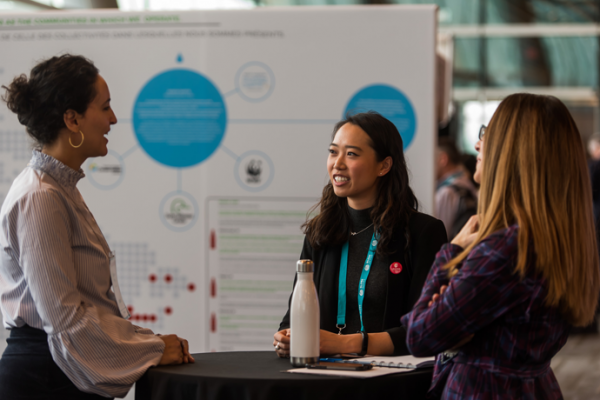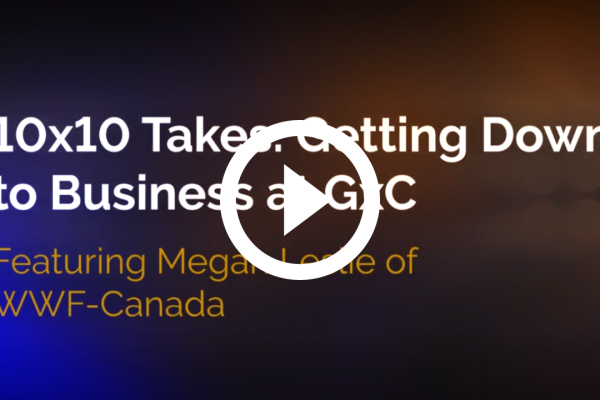GUEST CONTENT
Jon Mitchell, Vice President, Sustainability, Suncor joined the panel on Digital Transformation: Enabler or Enemy of a Resilient Future at GLOBE Capital to discuss the nexus of the energy transformation and digitalization. The months since the conference have been busy for Mr. Mitchell, with Suncor’s Investor Day in May and the launch of the Oil Sands Pathways to Net Zero initiative in June, followed by the company’s annual Report on Sustainability and Climate issued in July. We followed up with Mr. Mitchell to learn more about what net zero means for Suncor.
In late spring, you held your 2021 Investor Day and your strategy figured prominently. Tell us about your sustainability plans within the context of your strategy.
Our strategy is to be Canada’s leading energy company by growing our business in low greenhouse gas (GHG) fuels, electricity, and hydrogen, while sustaining and optimizing our existing hydrocarbon business and transforming our GHG footprint. All of this is enabled by our expertise, long-life resources, integrated business model, strong connection to customers, and world-class environment, social and governance (ESG) performance. It’s important to note that we don’t have a separate sustainability strategy—sustainability and the energy transition are integrated within the business strategy. It was our objective at the outset to ensure they were neither distinct from one another nor independent conversations.
As part of our strategy, one of our six strategic objectives is to become a net–zero company by 2050. To get there, we will be reducing emissions from our base business; expanding our low–emissions power, renewable fuels and hydrogen businesses; and working with our customers, suppliers and other stakeholders on reducing emissions elsewhere. To measure our progress, we’ve set a new target to reduce emissions across our value chain by 10 MT per year by 2030.
ESG investing has recently expanded into a USD$30 trillion-plus business. We’ve seen more and more investors seizing opportunities in the clean economy and advocating for the disclosure of climate-related business risks through the Task Force on Climate-Related Disclosure (TCFD), for example. How has this impacted investor relations at Suncor? Are your sustainability and IR teams working more closely together?
We’re fortunate that our investor relations and sustainability teams have always had a close working relationship, and over the past few years the collaboration between our teams has grown even more. Along with my colleagues from finance, I regularly meet with our investors, bankers, and insurers to discuss all aspects of our climate strategy, ESG performance and our actions to continually improve our disclosure. This is to ensure that we are meeting the needs of the investment community and that they have the information they need to make informed decisions about the material ESG issues that are shaping our business.
Suncor was an early adopter of the Sustainability Accounting Standards Board (SASB) oil and gas standards. We were also the first oil company in North America to signal support for the TCFD. We recently published our fifth stand-alone climate report and have been continuously progressing our alignment with the TCFD recommendations.
The Canadian government has committed to net-zero carbon emissions by 2050, alongside over 100 countries and many of the world’s largest corporations. To achieve this target on a global scale, the latest International Energy Agency (IEA) report recommends no new oil and gas developments. What does a net-zero future mean for Suncor and its sustainability strategy?
The drive to accelerate climate ambitions and net-zero commitments, both by governments and industry, is going to materially shift corporate strategies for decades to come. Suncor continues to progress along our sustainability journey and our strategy reflects our view of what is required to thrive as the energy system shifts to realize a net–zero future. Suncor’s strategy is aligned with the Paris Agreement and recognizes the need for the world to reach net–zero emissions by 2050. We also support Canada’s efforts to develop enabling policies, fiscal programs and regulations to provide predictability for the long-term, large-scale investments needed to achieve our country’s net–zero aspirations. Our purpose—to provide trusted energy while caring for each other and the earth—signals our intention to be a leading player in the energy transition. For us, that means reducing emissions in our base business and continuing to expand into low–GHG lines of business while working with customers and suppliers to help them reduce their emissions.
In their report, the IEA presents what it emphasizes is one possible route toward net–zero emissions in the energy sector. It should not be construed as a recommendation, but rather a scenario, and not the only scenario to realize the net–zero future we are all aspiring to achieve. Suncor continues to explore multiple scenarios and opportunities to reach net–zero emissions. Suncor also considers other key guidance, including the 2018 1.5°C report from the UN’s Intergovernmental Panel on Climate Change (IPCC) that outlined 90 possible scenarios for reaching net-zero emissions. In the end, all sectors must reduce their emissions substantially and as quickly as possible, and the oil sands sector is no exception. In Canada, the oil sands sector has set itself the goal of doing exactly this through its recent Pathways announcement.
The oil sands sector is well positioned to advance the technology, innovation, and investment needed to reach net zero. To bet otherwise underestimates the determination and talent that exists in these companies, and the power in the art of the possible.
Canada’s Net Zero Future report by the Canadian Institute for Climate Choices suggests there is a role for both safe bets (established solutions) and wild cards (unproven yet innovative tech) on the road to net zero. In terms of reducing emissions, what are the safe bets for Suncor and what are the wild cards?
As a company with a long history of successful innovation and technology development, we think the framing of safe bets and wild cards has the potential to oversimplify or discount solutions. Reducing emissions and preventing climate change is one of the most challenging and complex issues facing the world today. It will require tremendous innovation, collaboration, and all kinds of technologies, some of which have not been invented yet. We encourage a multitude of options because, as history has shown us, what is perceived as a wild card today may be a sure bet tomorrow—and vice versa. For example, in 1900, the electric car would have been considered a safe bet and the internal combustion engine a wild card. In the 1990s, the electric car would have been a wild card, but today it is a safe bet. To build on the analogy used by the CICC, in the card games I’ve played, the wild cards are the most powerful cards in the deck, so we shouldn’t underestimate the role they will play in realizing our climate objectives. Ultimately to win, or in this case meet our objectives, all cards in the deck need to be played.
There is an opportunity to empower and employ people who have been historically underrepresented in the energy sector—women, people of colour, and Indigenous peoples for example. What is Suncor doing to ensure that future talent and diverse perspectives are part of the energy future?
As a people-focused and purpose-driven company, we have a strong emphasis on diversity and inclusion, ensuring women, people of colour and Indigenous peoples feel included and represented in our workforce. Recent conversations and events over the last few years are shedding an even greater light on how critically important this is in our society and encouraging us to do more to address systemic racism and reconciliation with Indigenous peoples. We’re learning more as a company and offering programs, training, and forums to challenge our blind spots and our own biases to create a workplace that’s a great place for everyone.
We recently refreshed our social goal to the Journey of Reconciliation to reflect our continued transformation both within our organization and in our relationships with Indigenous peoples. It’s a journey that will require hard work and some uncomfortable reflections, but it’s necessary. It will require us to further foster a culture of inclusion, humility, and honesty, as well as a willingness to shift our mindsets and behaviours. On a personal note, I’ve had the privilege of participating in some of our Indigenous-led education programs that help to build a deeper understanding of the rich culture and history of Indigenous Peoples in Canada. Often when these experiential learning opportunities conclude, there is not a dry eye in the room. These have been some of the most powerful experiences in my career and have helped me on my own reconciliation, inclusion and diversity journey. I encourage all Canadians to seek out opportunities of their own to learn about Indigenous Peoples, their history and culture.
What does the just transition mean for Suncor?
We are always thinking about the impact of energy development on people and communities and that won’t change in the future. It is clear we can’t look at the energy transition through a single lens. We need to take a systems approach and recognize the economic, environmental, and social implications of the transition. This will open our minds to new ideas and expand our understanding of what the transition means to our country, our citizens and all the sectors of our economy—not just energy.
We believe the best way to manage impacts or major change is to be open and transparent and to seek input from those affected. Accounting for the impacts to people in energy development will continue to be critical to our success and the resilience of our business through the transition.
We’ve learned a lot from partnerships with Indigenous Peoples and communities and know that we often haven’t gotten it right in the past. We are committed to continuing to learn and make changes in our business through the Journey of Reconciliation. This includes efforts to further partner with Indigenous businesses and communities, strengthen Indigenous workforce and inclusion, incorporate Indigenous worldviews, and partner with Indigenous youth.
When it comes to communities, we have evolved our approach from simple philanthropy to working much more deeply alongside community partners to tackle complex social issues together. This social innovation approach is exemplified by the efforts of the Suncor Energy Foundation, with the goal of supporting communities near our operations to grow, thrive, and build long-term resilience.
We’re also committed to ensuring employees have the training and skills needed to work in the technology-enabled future. We think these skills will be foundational in the future and will help enable the future we are all seeking, regardless of the sector.
The energy transition will take many decades and our intention is to help shape and play a leadership role in the process and to be a trusted provider of energy now and in the future. Through that process, we will work with our employees and communities to manage the transition.
What is the greatest opportunity in sustainability in the next 10 years?
Throughout my career I’ve always enjoyed the challenges and opportunities presented by work in sustainability. The combination of complexity, impact, and values means that success makes a big difference. When I look out over the next ten years, I believe there will be an opportunity to improve sustainability outcomes at an unprecedented pace. The convergence of sustainable finance, corporate ambition, and social engagement brings together the ingredients we need to realize our climate and sustainability goals. I’m very optimistic because I see businesses mobilizing effort and collaboration on these challenges like never before; significant capital being mobilized to accelerate innovation by traditional sectors and emerging ones; engagement with Indigenous communities and youth unlocking new potential partnerships; top talent within firms is being deployed to develop solutions; and companies creating a sense of purpose that goes beyond the balance sheet. This combination of factors creates the potential to re-write our relationship with the environment and with each other. If we’re smart, we have the opportunity to implement solutions that will reduce our impact on the environment and lead to cleaner air and water, less waste, more forests, greater diversity, more liveable cities, healthier food choices, and a renewed value on nature. The possibilities for a better quality of life are endless and that’s what excites me about working in this area.
For more insights on the road to 2050, join our Destination Net Zero Events:
ENERGY AND TRANSPORTATION DAYS
Sept 28-29, 2021 | Virtual | Complimentary
NATURE AND BIOECONOMY DAYS
Nov 23-24, 2021 | Virtual | Complimentary
GLOBE FORUM
Mar 29-31, 2022 | Host Hub: Vancouver Convention Centre West | Virtual Programming | Partner Hubs Across Canada




